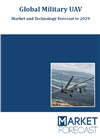Boeing [NYSE: BA] has introduced its newest unmanned platform, the Boeing Airpower Teaming System.
Designed for global defense customers by Boeing Australia, it is the company’s largest investment in a new unmanned aircraft program outside the United States.
The aircraft will complement and extend airborne missions through smart teaming with existing military aircraft.

Market forecasts by Region, Technology, Propulsion, Endurance, MTOW, Range, Launching system, Application, and End User. Market and Technologies Overview, Market Dynamics, Events Forecast, and Leading Companies
Download free sample pages More informationA model of the Boeing Airpower Teaming System was unveiled at the Australian International Airshow by the Australian Minister for Defence, the Hon. Christopher Pyne MP. As a research and development activity, the Australian Government and Boeing will produce a concept demonstrator called the Loyal Wingman – Advanced Development Program that will provide key learnings toward the production of the Boeing Airpower Teaming System.
“The Boeing Airpower Teaming System will provide a disruptive advantage for allied forces’ manned/unmanned missions,” said Kristin Robertson, vice president and general manager of Boeing Autonomous Systems. “With its ability to reconfigure quickly and perform different types of missions in tandem with other aircraft, our newest addition to Boeing’s portfolio will truly be a force multiplier as it protects and projects air power.”
The Boeing Airpower Teaming System will:
“This aircraft is a historic endeavor for Boeing. Not only is it developed outside the United States, it is also designed so that our global customers can integrate local content to meet their country-specific requirements,” said Marc Allen, president, Boeing International. “The Boeing Airpower Teaming System provides a transformational capability in terms of defense, and our customers – led by Australia – effectively become partners on the program with the ability to grow their own sovereign capabilities to support it, including a high-tech workforce.”
First flight is planned for 2020.